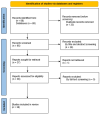Cannabis Use during Pregnancy: An Update
- PMID: 39459478
- PMCID: PMC11509407
- DOI: 10.3390/medicina60101691
Cannabis Use during Pregnancy: An Update
Abstract
The use of cannabis during pregnancy has emerged as a mounting cause for concern due to its potential adverse consequences on both the mother and her offspring. This review will focus on the dangers associated with prenatal exposure to cannabis, particularly those related to neurodevelopment. It will also discuss the features of maternal and placental functioning that are likely to have long-term effects on the offspring's development. The most pertinent and up-to-date materials can be found through a literature search. The literature emphasizes the substantial hazards associated with prenatal exposure to cannabis. These include impairments in cognitive function and difficulties in behavior in this particular instance. Structural and functional alterations in the brain can be noticed in offspring. The use of cannabis has been associated with an increased likelihood of experiencing pregnancy-related complications, such as giving birth prematurely and having a baby with a low birth weight. Additionally, it has been connected to potential negative effects on mental and emotional well-being. Studies have shown that when a pregnant woman is exposed to cannabis, it can negatively impact the functioning of the placenta and the growth of the fetus. This might potentially contribute to the development of placental insufficiency and restricted growth in the womb. Longitudinal studies reveal that children who were exposed to cannabis in the womb experience additional long-term developmental challenges, such as decreased cognitive abilities, reduced academic performance, and behavioral issues. In order to address the problem of cannabis usage during pregnancy, it is essential to adopt a comprehensive and coordinated strategy. This method should integrate and synchronize public health policy, education, and research initiatives. By implementing these targeted strategies, it is possible to mitigate potential health and welfare concerns for both present and future generations.
Keywords: long-term developmental outcomes; maternal health risks; neurodevelopmental outcomes; placental function; prenatal cannabis exposure; public health policy.
Conflict of interest statement
The authors declare no conflicts of interest.
Figures
Similar articles
-
Long-term effects of maternal cannabis vapor exposure on emotional reactivity, social behavior, and behavioral flexibility in offspring.Neuropharmacology. 2020 Nov 15;179:108288. doi: 10.1016/j.neuropharm.2020.108288. Epub 2020 Aug 26. Neuropharmacology. 2020. PMID: 32860776
-
Prenatal methadone exposure disrupts behavioral development and alters motor neuron intrinsic properties and local circuitry.Elife. 2021 Mar 16;10:e66230. doi: 10.7554/eLife.66230. Elife. 2021. PMID: 33724184 Free PMC article.
-
An epidemiological, developmental and clinical overview of cannabis use during pregnancy.Prev Med. 2018 Nov;116:1-5. doi: 10.1016/j.ypmed.2018.08.036. Epub 2018 Aug 29. Prev Med. 2018. PMID: 30171964 Review.
-
Cannabis and Pregnancy.Curr Psychiatry Rep. 2024 Nov;26(11):643-649. doi: 10.1007/s11920-024-01536-x. Epub 2024 Sep 24. Curr Psychiatry Rep. 2024. PMID: 39316227 Review.
-
Prenatal cannabis exposure - The "first hit" to the endocannabinoid system.Neurotoxicol Teratol. 2016 Nov-Dec;58:5-14. doi: 10.1016/j.ntt.2016.08.003. Epub 2016 Aug 24. Neurotoxicol Teratol. 2016. PMID: 27567698
References
-
- Chouvy P.A. Pierre-Arnaud Cannabis Cultivation in the World: Heritages, Trends and Challenges. EchoGéo. 2019;48:1–20. doi: 10.4000/echogeo.17591. - DOI
-
- Ayşe N.K., Mehmet A.Y., Zeynep S.Y. The Evolution of Maternal Well-Being: A Journey through Pregnancy’s Physiological, Physical, and Emotional Realms. Glob. J. Med. Health Sci. 2024;11:18–28. doi: 10.5281/ZENODO.10568786. - DOI
Publication types
MeSH terms
Grants and funding
LinkOut - more resources
Full Text Sources


